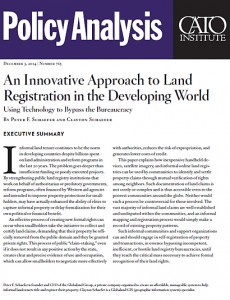 A new paper published by Cato Institute’s Policy Analysis open new perspectives for defining and securing property rights in the developping world as adocated by Hernado De Soto.
A new paper published by Cato Institute’s Policy Analysis open new perspectives for defining and securing property rights in the developping world as adocated by Hernado De Soto.
Because property rights, secure tenure, and access to low-cost secured credit is crucial for self-sustained, long-term economic development, it seems sensible that billions of aid dollars have been spent over the last decade trying to help governments carry out
a process of formalization.
However, in practice these projects have been unable to incorporate significant numbers of urban squatters and traditional landholders into the global market economy. Although there have been several national registry programs that operated on a large scale, there are
inherent limitations to state-led efforts. Using inexpensivehand-held devices and satellite imagery, informal communities can now take the first step by self-mapping their property claims.
Creating a global system of extra-governmental property rights based on open access and community participation could be the first step in a process that leads to secure and legally recognized land tenure, active real estate markets, and affordable secured credit.
Since property rights are a prerequisite to environmental conservation it is most important to consider this new approoach
which could help to solve Hardin’s “Tragedy of the Commons” and Ostrom’s “Common pool resource management”